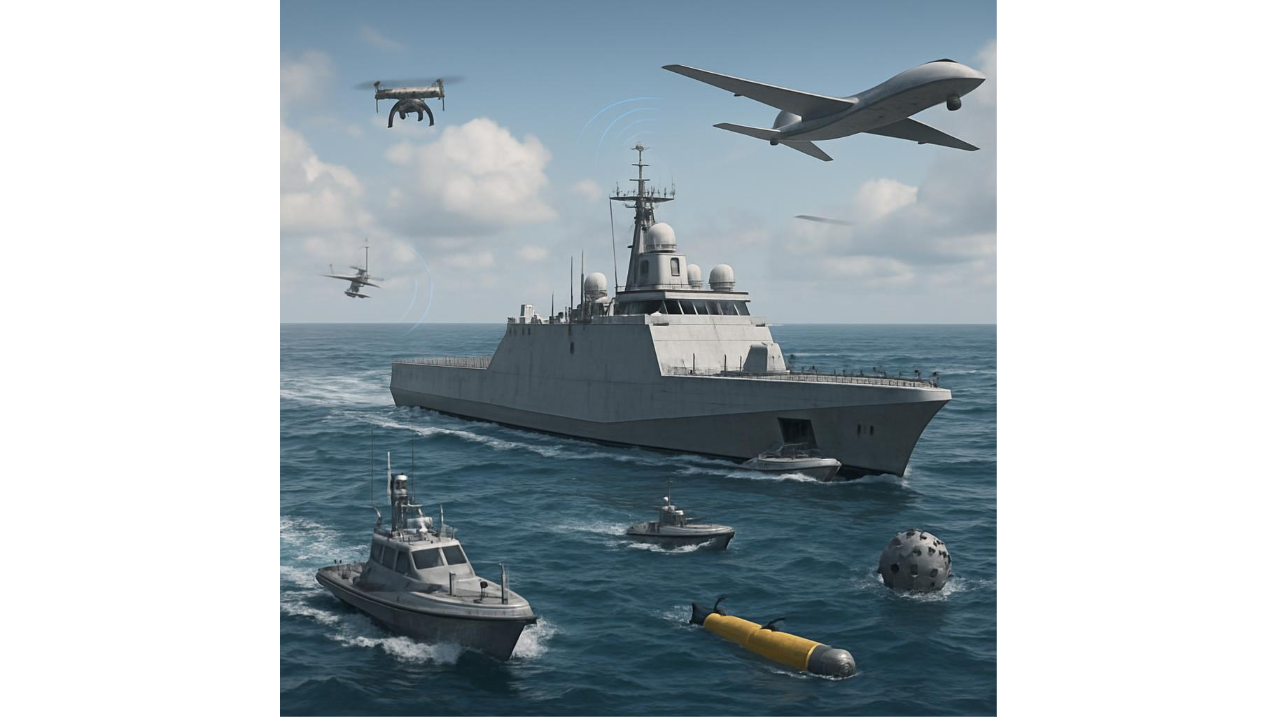By George Galdorisi
The U. S. Navy stands at the precipice of a new era of technology advancement. In an address at a military-industry conference, the then-U.S. Chief of Naval Operations, Admiral Michael Gilday, revealed the Navy’s goal to grow to 500 ships, to include 350 crewed ships and 150 uncrewed maritime vessels. This plan has been dubbed the “hybrid fleet.” More recently, this sea change for the “Navy-After-Next” was embodied in the Navy’s Navigation Plan for America’s Warfighting Navy.
The reason for this commitment to uncrewed maritime vessels is clear. During the height of the Reagan Defense Buildup in the mid-1980s, the U.S. Navy evolved a strategy to build a “600-ship Navy.” That effort resulted in a total number of Navy ships that reached 594 in 1987. That number has declined steadily during the past three-and-one-half decades, and today the Navy has less than half the number of commissioned ships than it had then. However, the rapid growth of the technologies that make uncrewed surface vessels (USVs) increasingly capable and affordable has provided the Navy with a potential way to put more hulls in the water.
Juxtaposed against this aspiration is the fact that the U.S. Congress has been reluctant to authorize the Navy’s planned investment of billions of dollars in USVs until the Service can come up with a concept of operations (CONOPS) for using them. Congress has a point. The Navy has announced plans to procure large numbers of uncrewed systems—especially large and medium uncrewed surface vessels—but a CONOPS, one in even the most basic form, has not yet emerged.
That said, the Navy has taken several actions to define what uncrewed maritime vessels will do and thus accelerate its journey to have uncrewed platforms populate the fleet. These include publishing an UNCREWED Campaign Framework; standing up an Uncrewed Task Force; establishing Surface Development Squadron One in San Diego and Uncrewed Surface Vessel Division One in Port Hueneme, California; and conducting many exercises, experiments and demonstrations where Navy operators have had the opportunity to evaluate uncrewed maritime vessels.
These initiatives will serve the Navy well in evolving a convincing CONOPS to describe how these innovative platforms can be leveraged. Fleshing out how this is to be done will require that the Navy describe how these platforms will get to the operating area where they are needed, as well as what missions they will perform once they arrive.
An evolving concept of operations is to marry various size uncrewed surface, subsurface and aerial uncrewed vehicles to perform missions that the U.S. Navy has—and will continue to have—as the Navy-After-Next evolves. The Navy can use a large uncrewed surface vessel (LUSV) as a “truck” to move smaller USVs, UUVs and UAVs into the battle space to perform several important Navy missions such as intelligence, surveillance and reconnaissance (ISR) and mine-countermeasures (MCM). Further, the Navy does not have to wait for a lengthy acquisition process to field capable USVs. Rather, it can use commercial-off-the-self (COTS) USVs and field them soon.
How would this CONOPS for a hybrid fleet evolve? Consider the case of an Expeditionary Strike Group comprised of several amphibious ships underway in the Western Pacific. This Strike Group includes three LUSVs. Depending on the size that is ultimately procured, the LUSV can carry several medium USVs (MUSVs) and deliver them to a point near the area of operations.
These vessels can be sent independently to perform the ISR mission, or alternatively, can launch one or more smaller USVs to perform this mission. Building on work conducted by the Navy laboratory community and sponsored by the Office of Naval Research, MUSVs will have the ability to launch uncrewed aerial vehicles to conduct overhead ISR.
For the MCM mission, the LUSV can deliver several MUSVs equipped with mine-hunting and mine-clearing systems (all of which are COTS platforms such as the MCM-USV, T38 Devil Ray, Shadow Fox and others tested extensively in Navy exercises). Indeed, the T38 Devil Ray has performed this mission in Pacific Fleet-sponsored exercises. These vessels can then undertake the “dull, dirty and dangerous” work previously conducted by Sailors who had to operate in the minefield.
While the full details of how this CONOPS plays out is beyond the scope of this article, this innovative approach accomplishes an important goal. If the U.S. Navy wants to keep its multi-billion-dollar capital ships out of harm’s way, it will need to surge uncrewed maritime vessels into the contested battlespace while its crewed ships stay out of range of adversary anti-access/area denial systems, sensors and weapons.
To be clear, this is not a platform-specific solution, but rather a concept. When fleet operators see a capability with different size uncrewed COTS platforms in the water working together and successfully performing these missions, they will likely press industry to produce even more-capable platforms to perform these missions and thereby accelerating the fielding of a hybrid fleet.
This U.S. Navy hybrid fleet initiative has significant implications for the industry. The uncrewed systems industry is investing in increasing capacity to produce various sized USVs for military missions. This will drive down the unit cost of these vessels which will, in turn, make them more affordable for civilian uses such as remote ocean monitoring, oceanographic surveys and sensing, protecting offshore infrastructure and a host of other missions currently conducted by crewed vessels.
This article was first published in Ocean News and Technology and is reposted with the author’s permission.
Featured image was generated by an AI program.
The generated image portrays a futuristic Navy operation. It features a large uncrewed surface vessel (LUSV) acting as a mobile base, surrounded by smaller uncrewed surface, subsurface, and aerial vehicles. These vehicles are engaged in intelligence, surveillance, reconnaissance (ISR), and mine-countermeasures (MCM) missions. The setting is an oceanic environment, highlighting advanced technology and the use of commercial-off-the-shelf (COTS) vehicles for rapid deployment.


